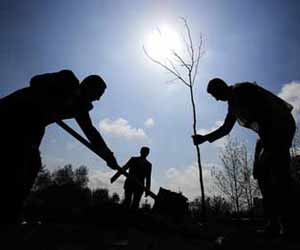Treeplanting Jobs
Do you seek being in the outdoors as much as you possibly can? Do you enjoy meeting new and diverse people? Combine those with a healthy dose of physically demanding manual labor and treeplanting may be for you.
At its core, treeplanting jobs simply involve planting seedlings over an area of land where the forest has been harvested or damaged by fire, disease or insects. The responsibility to re-establish these areas belongs to the company that either had the trees cut for their use or purchased a contract to re-establish the forest area. These companies typically hire private treeplanting companies, who then hire individual tree planters to plant the seedlings. Most treeplanting occurs between May and the beginning of July, with the actual hiring occurring in the beginning of each year.

Payment for treeplanting occurs for each seedling planted that meets quality standards. It will vary by location, terrain and employer, but typically ranges between $0.08 and $0.25 per tree. Employer personnel will perform random quality checks, such as digging up recently planted seedlings, checking for optimum seedling orientation, spacing and depth or verifying the seedlings are in acceptable soil, before making payment. In British Columbia, typical contracts allow for a seven percent fail rate, with anything higher resulting in a proportional loss of payment. Greater than 25 percent failure usually results in held payment.
— View Agriculture and Forestry Job Postings —
Personal characteristics, more than education and qualifications, are of utmost importance to be a successful treeplanter. For starters, a strong work ethic is crucial. Time spent relaxing or skipping work completely results in lost payment opportunity.
The ability to learn quickly is important as well. Not every treeplanting company has exactly the same requirements, so the ability to understand new requirements quickly will result in increased earnings.
The ability to work and live with a wide range of personalities greatly increases a treeplanter’s success, because the field draws a diverse crowd. Treeplanters typically live at the site where they are working, which means everyone has to pitch in with all camp activities. Working together with that diverse crowd in camp goes a long way towards forming good relationships and keeping the actual planting on task.
Safety and ergonomics are critical to the treeplanter. An average day involves planting over 1,000 seedlings. Carrying those seedlings in specially developed tree planting bags puts a daily toll on the body. In addition, the repetitive motion of driving a shovel into the ground for each seedling will stress the body more than what it typically experiences. Proper form and technique are crucial to avoiding injury and the resultant lost earnings.


 Teach English in Asia
Teach English in Asia  Cruise Ship Jobs
Cruise Ship Jobs  Alaska Fishing Industry Jobs
Alaska Fishing Industry Jobs  Sharing Economy / Gig Economy
Sharing Economy / Gig Economy